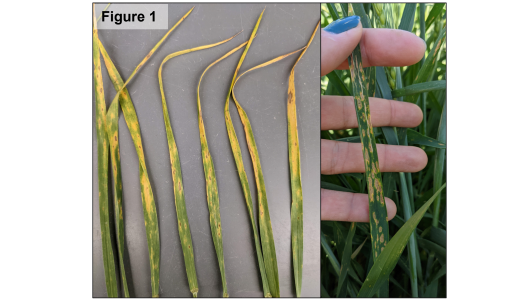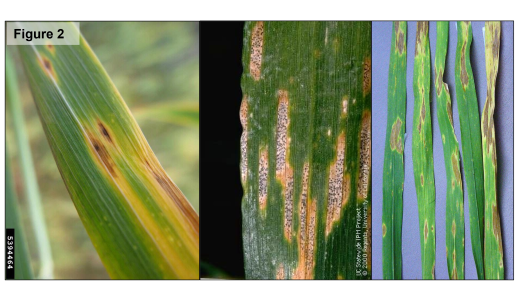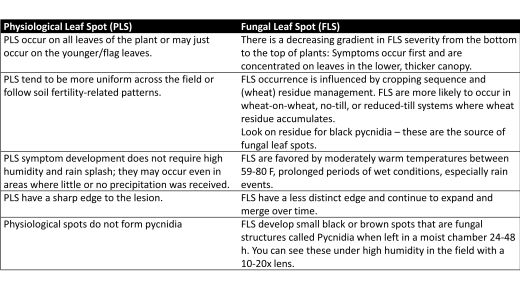
Distinguishing and Managing Physiological and Fungal Leaf Spots in Winter Wheat
This AgAlert discusses differentiation, characteristic symptoms, risk factors, and treatment options for PLS and fungal leaf spots on wheat and includes resources on fungicide applications.
Quick Summary for Busy People
- Physiological leaf spots are prevalent in winter wheat across the state. Physiological leaf spots are caused by Chloride deficiency. Fungicide applications are not effective, but chloride fertilizer can help.
- Fungal leaf spots may occur where wet and moderately warm weather is observed. Fungicide applications are effective but may not be necessary depending on the crop growth stage.
- Take the time to diagnose/get diagnosed the cause for the leaf spot before you make treatment decisions
I have received several samples and heard/seen reports of yellowing winter wheat with spots of various shape, color, and size from across the state. Physiological leaf spot (PLS) is once again prevalent in winter wheat this year. Some winter wheat varieties are prone to PLS, for example Bobcat. PLS are not caused by a (fungal) pathogen, but are instead related to environmental conditions, most likely Chloride deficiency. This means that fungicide applications will not be effective in managing PLS.
Tan spot, which is a foliar disease of small grains caused by a fungal pathogen, can look very similar to PLS. I have diagnosed several winter wheat (and one spring wheat) samples with Tan spot this week, telling me this disease is active, although likely more localized. Fungal leaf spots (FLS) can be managed with fungicides. Distinguishing between fungal leaf spots and PLS is difficult but important.
1. Differentiation between Physiological and Fungal Leaf Spots - a "quick and dirty" key
2. Physiological Leaf Spots (PLS) Certain winter wheat varieties are more prone to PLS. Over the past years, Bobcat has repeatedly developed PLS. Please note that Bobcat has been performing very well throughout its development process at MSU, even in the presence of PLS. PLS symptoms typically appear from flag leaf emergence to boot stage, but I have seen plants at earlier growth stages developing PLS this spring. PLS appear as circular to oblong, dark brown or chlorotic lesions and the tissue in the center looks bleached, white to gray in color (Figure 1). The lesions are often surrounded by narrow chlorotic (yellow) halos and tend to be more numerous toward the tip of the leaf blade. PLS lesions have more discrete margins compared to fungal leaf spots, which are more diffuse and continue to expand over time. Most importantly, PLS do not develop small black spots in the center of the lesion when kept in a humid environment for 24-48 hours. PLS is often caused by chloride deficiency. Low chloride uptake by the plants could occur in sandy soil with high rainfall because the chloride has leached, but also in droughty soils where root growth is reduced. If you want to rule out or rule in chloride deficiency, I suggest you do a tissue test for chloride concentration. The suggested critical level in plant material (entire plant) is between 0.1 and 0.4%, with large yield increases and leaf spot decreases when chloride was applied at tissue chloride concentrations below 0.1%. Applying 10-20 lb potash (0-0-60) per acre should be sufficient (5-10 lb Cl/acre) to mitigate chloride deficiency. Alternatively, a similar amount of chloride can be applied as a liquid (for example calcium chloride or ammonium chloride). Dry fertilizer applications can be applied at any time through the late jointing stage, depending on sufficient rain (or irrigation). Liquid formulations can be applied to the foliage up to the time of flag leaf emergence. In many areas in the state, it might get a little late for foliar applications for PLS management (hence the rushed AgAlert). Please note that the Schutter Diagnostic Lab does not offer tissue analysis or soil testing services but most independent labs test for chloride. Please contact Clain Jones (Phone: 406-994-6076; Email: [email protected]) for questions on tissue testing and soil fertility management recommendations. |
 Figure 1. Physiological leaf spot symptoms on winter wheat variety Bobcat at early jointing (left) and boot stage (right). Photo credit: Uta McKelvy, Montana State University. |
3. Fungal Leaf spots (FLS)
Fungal leaf spots on Montana wheat include Tan spot, Septoria tritici blotch, and Stagonospora leaf spot. Tan spot tends to be most prevalent in the state, and certainly this growing season. These diseases are residue borne. Wheat-on-wheat cropping sequences and residue management practices (no-till or reduced-till) that accumulate wheat residue in the field are factors that promote fungal leaf spots. Fungal leaf spots are more concentrated in the lower canopy, which is closer to the residue (source of inoculum) and where it is more humid. Wet and humid weather favors fungal leaf spot diseases. Septoria tritici blotch develops at cool temperatures of 59 - 68 F; Tan spot and Stagonospora leaf blotch develop at moderate temperatures of 68 - 75 F. In other words, if you live in a part of Montana that has experienced a lot of precipitation lately while temperatures are still cool to moderately warm, fungal leaf spot diseases are to be expected.
 Figure 2. Leaf spot symptoms associated with tan spot (left), Septoria tritici blotch (middle), and Stagonospora leaf blotch (right). Photo credit: (left) Mary Burrows, Montana State University; (middle) Jack Kelly Clark, UC IPM Program; (right) Paul Bachi, University of Kentucky. |
Fungal Leaf Spot Symptoms (Figure 2):
Tan spot is caused by Pyrenophora tritici-repentis. Initial symptoms will be small, brown leaf spots that enlarge and develop tan necrotic spots surrounded by yellow halos. The lesions are initially oval and take on a diamond shape as they enlarge. When kept in a humid environment, a pinhead-sized black spot will develop in the center of the lesion.
Septoria tritici blotch is caused by Zymoseptoria tritici. The disease starts out as tan to brown lesions on the lower leaves, which have an elliptical to rectangular shape and form between leaf veins. The lesions enlarge and their centers become necrotic. Dark fruiting bodies will develop in the lesions, giving them a speckled appearance (as if sprinkled with cracked peppercorns).
Stagonospora leaf blotch is caused by Parastagonospora nodorum. The disease may first become evident on the lower leaves as small yellow spots. The spots will enlarge into elliptical, lens-shaped lesion of gray or brown color and will be surrounded by yellow margins. In the center of the lesions, you may observe small, brown dot-like structures, which are called pycnidia. The lesions can coalesce to form large areas of brown, necrotic tissue on the leaves.
Fungal Leaf Spot Management
Fungicide applications are effective at managing fungal leaf spots. I strongly recommend you bring a sample to your local Extension agent or submit one to the Schutter Diagnostic Lab for diagnosis before you plan a fungicide application. If you send a sample to the clinic for confirmation, please let us know if you've already applied a fungicide - if you have, it's unlikely we will be able to recover spores.
With a fungicide application, protecting the flag leaf from disease is key. You can find resources on fungicide use, application decisions, and suitable modes of actions below. Varieties that are less susceptible to leaf spot pathogens are available. Areas with high wheat residue cover are likely disease hot spots and can be managed by practices of residue decomposition and removal. Crop rotation is also effective.
4. Where you can find more information
Fungal Leaf Spots and other wheat diseases:
- MSU Extension Plant Pathology Resources Website (Plant Diseases and Management)
- The Crop Protection Network
Resources on Fungicide use (decision) and suitable modes of actions:
Please don't hesitate to email ([email protected]) or call (406-994-557) if you have any questions.
Uta McKelvy
